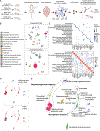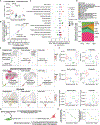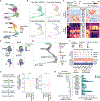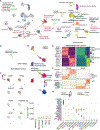Tracking cell-type-specific temporal dynamics in human and mouse brains
- PMID: 37774676
- PMCID: PMC10545416
- DOI: 10.1016/j.cell.2023.08.042
Tracking cell-type-specific temporal dynamics in human and mouse brains
Abstract
Progenitor cells are critical in preserving organismal homeostasis, yet their diversity and dynamics in the aged brain remain underexplored. We introduced TrackerSci, a single-cell genomic method that combines newborn cell labeling and combinatorial indexing to characterize the transcriptome and chromatin landscape of proliferating progenitor cells in vivo. Using TrackerSci, we investigated the dynamics of newborn cells in mouse brains across various ages and in a mouse model of Alzheimer's disease. Our dataset revealed diverse progenitor cell types in the brain and their epigenetic signatures. We further quantified aging-associated shifts in cell-type-specific proliferation and differentiation and deciphered the associated molecular programs. Extending our study to the progenitor cells in the aged human brain, we identified conserved genetic signatures across species and pinpointed region-specific cellular dynamics, such as the reduced oligodendrogenesis in the cerebellum. We anticipate that TrackerSci will be broadly applicable to unveil cell-type-specific temporal dynamics in diverse systems.
Keywords: aging; cell-type-specific; neurogenesis; oligodendrogenesis; single-cell epigenome; single-cell transcriptome; temporal dynamics.
Copyright © 2023 The Author(s). Published by Elsevier Inc. All rights reserved.
Conflict of interest statement
Declaration of interests J.C., W.Z., Z.L., and M.Z. are inventors of patent applications related to TrackerSci.
Figures







Similar articles
-
A global view of aging and Alzheimer's pathogenesis-associated cell population dynamics and molecular signatures in human and mouse brains.Nat Genet. 2023 Dec;55(12):2104-2116. doi: 10.1038/s41588-023-01572-y. Epub 2023 Nov 30. Nat Genet. 2023. PMID: 38036784 Free PMC article.
-
Single-cell transcriptomics reveals gene signatures and alterations associated with aging in distinct neural stem/progenitor cell subpopulations.Protein Cell. 2018 Apr;9(4):351-364. doi: 10.1007/s13238-017-0450-2. Epub 2017 Jul 26. Protein Cell. 2018. PMID: 28748452 Free PMC article.
-
Spatial epigenome-transcriptome co-profiling of mammalian tissues.Nature. 2023 Apr;616(7955):113-122. doi: 10.1038/s41586-023-05795-1. Epub 2023 Mar 15. Nature. 2023. PMID: 36922587 Free PMC article.
-
Single-Cell Sequencing of Brain Cell Transcriptomes and Epigenomes.Neuron. 2021 Jan 6;109(1):11-26. doi: 10.1016/j.neuron.2020.12.010. Neuron. 2021. PMID: 33412093 Free PMC article. Review.
-
Therapeutic potential of neurogenesis for prevention and recovery from Alzheimer's disease: allopregnanolone as a proof of concept neurogenic agent.Curr Alzheimer Res. 2006 Jul;3(3):185-90. doi: 10.2174/156720506777632817. Curr Alzheimer Res. 2006. PMID: 16842093 Review.
Cited by
-
Single-cell sequencing to multi-omics: technologies and applications.Biomark Res. 2024 Sep 27;12(1):110. doi: 10.1186/s40364-024-00643-4. Biomark Res. 2024. PMID: 39334490 Free PMC article. Review.
-
Targeting the peripheral neural-tumour microenvironment for cancer therapy.Nat Rev Drug Discov. 2024 Oct;23(10):780-796. doi: 10.1038/s41573-024-01017-z. Epub 2024 Sep 6. Nat Rev Drug Discov. 2024. PMID: 39242781 Review.
-
Dentate gyrus is needed for memory retrieval.Mol Psychiatry. 2024 Oct;29(10):2939-2950. doi: 10.1038/s41380-024-02546-0. Epub 2024 Apr 12. Mol Psychiatry. 2024. PMID: 38609585 Free PMC article.
-
Advancements and applications of single-cell multi-omics techniques in cancer research: Unveiling heterogeneity and paving the way for precision therapeutics.Biochem Biophys Rep. 2023 Nov 29;37:101589. doi: 10.1016/j.bbrep.2023.101589. eCollection 2024 Mar. Biochem Biophys Rep. 2023. PMID: 38074997 Free PMC article. Review.
-
Aging- and Alzheimer's disease-related rare cell type dynamics in the mammalian brain unveiled.Nat Genet. 2023 Dec;55(12):2027-2028. doi: 10.1038/s41588-023-01573-x. Nat Genet. 2023. PMID: 38049667 No abstract available.
References
-
- Lugert S, Basak O, Knuckles P, Haussler U, Fabel K, Götz M, Haas CA, Kempermann G, Taylor V, and Giachino C (2010). Quiescent and active hippocampal neural stem cells with distinct morphologies respond selectively to physiological and pathological stimuli and aging. Cell Stem Cell 6, 445–456. - PubMed
-
- Pollina EA, and Brunet A (2011). Epigenetic regulation of aging stem cells. Oncogene 30, 3105–3126. - PubMed
Publication types
MeSH terms
Substances
Grants and funding
LinkOut - more resources
Full Text Sources
Medical
Molecular Biology Databases

